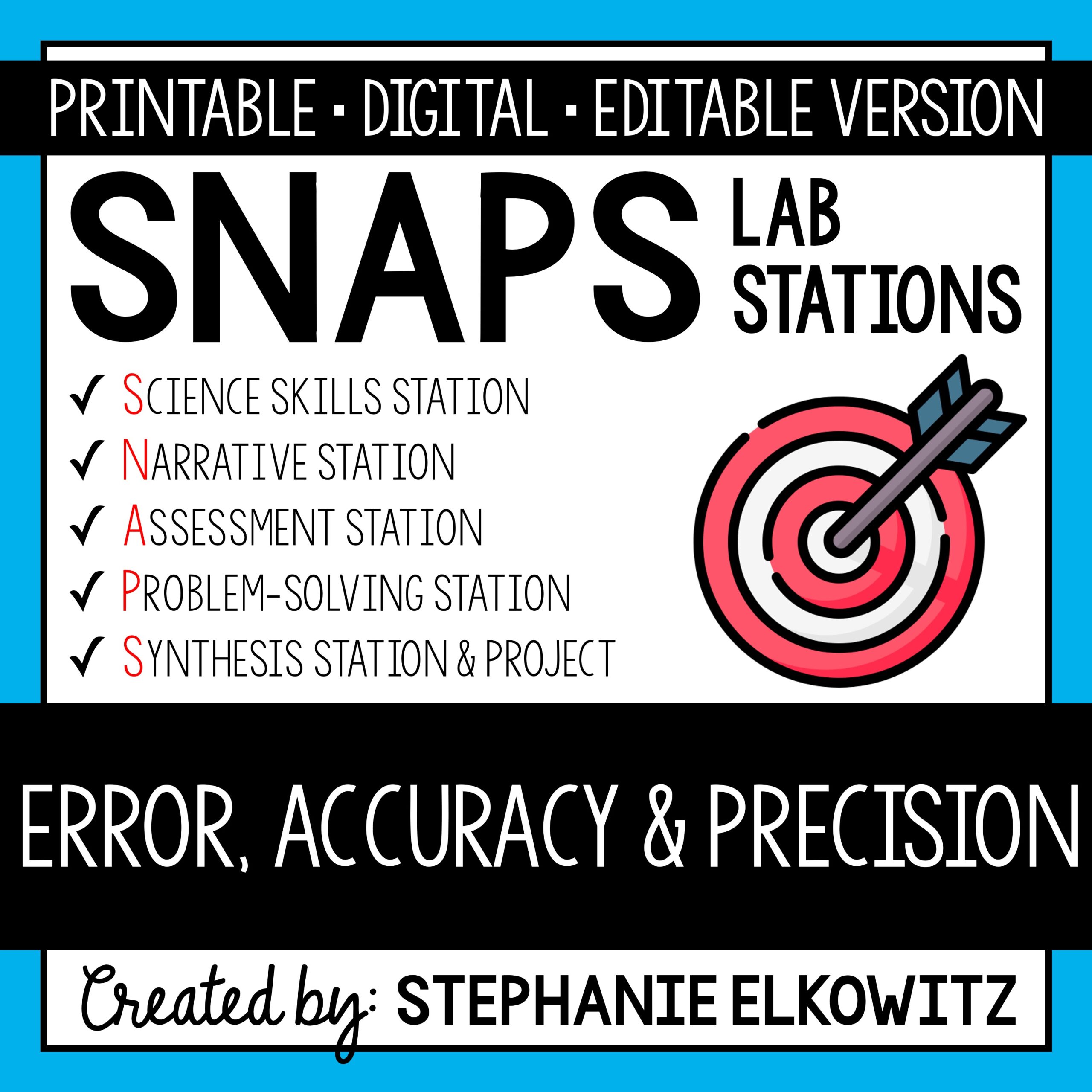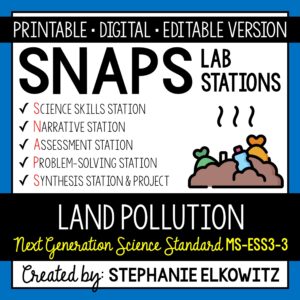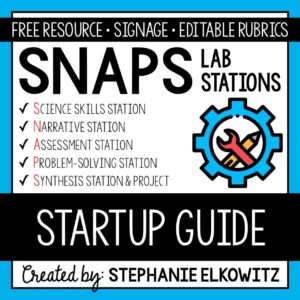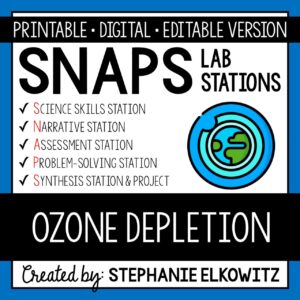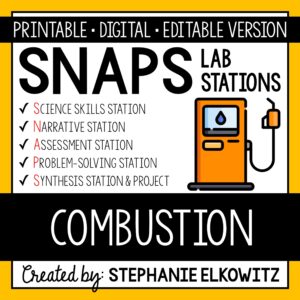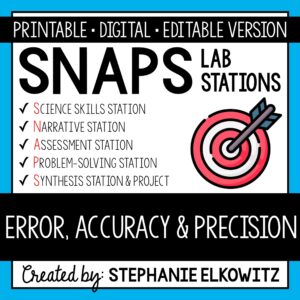Scientific Method Lab
$7.00
An engaging lab activity designed to enhance students’ understanding of the steps of the scientific method and how to identify variables and set up a controlled experiment to produce reliable results.
Description
SNAPs Lab Stations Activities require students to use science, math, literacy, problem-solving and engineering skills. They are designed to enhance students’ understanding of scientific concepts and help students apply scientific ideas to the real world. Each station activity promotes skills so to develop students into proficient and competent scientific thinkers.
SNAPs lab activities have five components:
• Science Skills Station to develop science skill proficiency
• Narrative Station to build science literacy
• Assessment Station to evaluate learning and understanding
• Problem-Solving Station to foster engineering design
• Synthesis Station and Project to inspire higher-order learning
DIGITAL LABORATORY – DISTANCE LEARNING & DIGITAL CLASSROOMS
• This lab is offered in a digital format to support digital classrooms & distance learning.
• The digital lab activity is designed to work with Google Slides and Microsoft PowerPoint
• The digital lab activity CANNOT be edited. However:
– Students can manipulate text boxes
– Students can create tables, graphs and diagrams
– Students can insert images and drawings
GOOGLE FORM ASSESSMENT STATION
• The assessment station is offered as a self-grading Google Form.
• Questions are all short answer and are 100% editable.
• Suggestions for use are included in the download.
DISTANCE LEARNING COMPATIBILITY
SNAPs lab activities are rated for their ease with distance – independent learning. Refer to the preview for more information about how well this laboratory works in a fully digital classroom and with distance learning.
EDITABLE DOCUMENTS
This download includes an editable word document (docx file) of all lab components:
• Pre-Lab and Post-Lab Activities
• The Lab Overview
• Lab Station Activities and Questions
• Directed Synthesis Project (when applicable)
Important Notes:
• Diagrams, illustrations, tables and graphs essential to lab activities are included
• Illustrative clipart is NOT included
• Editable documents and rubrics are included with the FREE SNAPs Setup Guide
Editable files allow you to:
• Edit the scope of the activities so to suit your students’ needs
• Edit the materials required based on resource availability
• Create single-period “mini-labs” using activities at the individual skills stations
The activities at each station in this lab are detailed below.
Scientific Method Lab Stations Activity Learning Objectives
1. Identify the steps of the scientific method.
2. Identify variables in a controlled experiment.
3. Competently use the scientific method so to design controlled experiments that achieve reliable and accurate data.
4. Evaluate experiments so to improve the reliability and accuracy of evidence generated from scientific investigations.
Science Skills Station
First, students will read about two different experiments. will analyze data in a table and graph and evaluate whether the experimenters make valid claims (conclusions) from the data collected. Second, students will be provided a testable question. From this question, they will form a hypothesis and plan an investigation that will answer the question. They will identify variables and create a table to record the data. Students will not actually perform an investigation.
Narrative Station
At this station, students will read about the scientific method. They will also watch a video about how scientific experiments are important to generating additional questions that can be answered with additional scientific experiments.
Assessment Station
At this station, students will answer questions about key terms and ideas relating to the scientific method. Students must use lower, mid and higher order thinking skills to answer these questions.
Problem-Solving Station
At this station, students will define problems with two experiments. They will develop solutions so to improve the reliability and accuracy of the data collected during the experiments. In one experiment, students will evaluate possible solutions put forth by the experimenters.
Synthesis Station
Students will compose a CER (claim-evidence-reasoning) report to summarize the lab. Students are provided the claim statement and must support the claim with observations, data and other information gathered in the lab. Students will explain how the evidence supports the claim using scientific reasoning.
Synthesis Project
Students will have a choice of 11 projects. Refer to the SNAPs Lab Stations Best Practices and Setup Guide for directions and suggestions on how to conduct the project.
This download includes:
• A pre-lab assignment and post-lab reflection
• Directions and questions for each lab station
• Student recording sheets
• Teacher Key
Additional Materials Required:
1 Computer or tablet
5 Dirty pennies
1 Bottle of water
1 Small bottle of white vinegar (the smallest you can find)
1 Small bottle of dish soap (travel size)
1 Laundry stain remover (such as a Tide™ stick or Oxiclean™ spray)
1 bottle all-purpose or bathroom cleaning spray
1 Toothbrush
1 Cotton ball
Box of tissues
LINKS TO VIDEOS
This laboratory requires internet to access videos. Videos are hosted on SafeShare.TV so to safely watch and share educational YouTube videos without ads, comments and other distractions. Shortened and full link(s) to SafeShare.TV included. Full link to original YouTube video(s) included.
NEXT GENERATION SCIENCE STANDARDS
The concepts and skills addressed in this product align with the NGSS Nature of Science eight major themes. This product addresses themes that extend the science and engineering practices and cross-cutting concepts across grades 3-5 and 6-8. These practices are outlined in Appendix F and H at http://www.nextgenscience.org/get-to-know.
TERMS OF USE
• All rights reserved by Stephanie Elkowitz.
• This product is to be used by the original purchaser only.
• Intended for classroom and personal use only.
• Copying for more than one teacher, classroom, department, school, or school system is prohibited.
• This product may not be distributed or displayed digitally for public view.
• Failure to comply is a copyright infringement and a violation of the Digital Millennium Copyright Act (DMCA).


